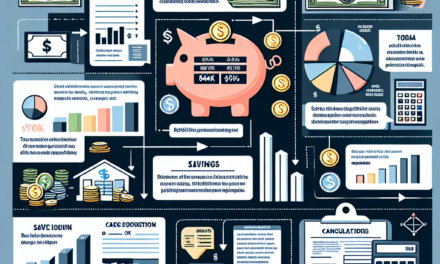“Unlock Triple-Digit Growth: Wall Street’s Top 3 Stock-Split Picks for 111% Gains!”
Introduction
Investors are always on the lookout for opportunities that promise substantial returns, and stock splits often signal such potential. According to Wall Street analysts, three companies are currently poised for stock splits that could lead to impressive gains of up to 111%. These opportunities arise when companies decide to divide their existing shares into multiple ones, making the stock more affordable and potentially attracting a broader base of investors. This strategic move can lead to increased liquidity and market interest, often driving the stock price higher. The companies identified by analysts are not only considering stock splits but also exhibit strong fundamentals and growth prospects, making them attractive candidates for investors seeking significant returns.
Understanding Stock Splits: A Beginner’s Guide
Stock splits are a fascinating phenomenon in the financial world, often capturing the attention of both novice and seasoned investors. At their core, stock splits are a corporate action in which a company divides its existing shares into multiple new shares. While the total market capitalization of the company remains unchanged, the number of shares outstanding increases, and the price per share decreases proportionally. This maneuver can make a stock more accessible to a broader range of investors, potentially increasing liquidity and market interest.
To understand the potential benefits of stock splits, it is essential to consider the psychological and practical impacts on investors. When a company’s share price becomes too high, it may deter smaller investors from purchasing the stock. By splitting the stock, the company effectively lowers the price per share, making it more affordable and attractive to a wider audience. This increased accessibility can lead to a rise in demand, which, in turn, may drive the stock price higher over time. Wall Street analysts often highlight stock splits as opportunities for significant gains, sometimes predicting returns as high as 111%.
Moreover, stock splits can signal a company’s confidence in its future performance. Companies typically announce stock splits when they are experiencing strong growth and expect continued success. This positive outlook can further entice investors, as it suggests that the company is on a solid trajectory. Consequently, stock splits can serve as a catalyst for renewed investor interest and enthusiasm, potentially leading to substantial gains.
However, it is crucial to recognize that stock splits do not inherently change the fundamental value of a company. The intrinsic value remains the same, as the split merely alters the share structure. Therefore, investors should not rely solely on stock splits as an indicator of a company’s potential for growth. Instead, they should consider other factors, such as the company’s financial health, market position, and growth prospects, to make informed investment decisions.
In addition to understanding the mechanics and implications of stock splits, investors should also be aware of the different types of splits. The most common is the forward stock split, where a company increases its number of shares and reduces the price per share. Conversely, a reverse stock split reduces the number of shares and increases the price per share. While forward splits are generally viewed positively, reverse splits can sometimes signal financial distress, as companies may use them to boost their share price to meet exchange listing requirements.
As Wall Street analysts continue to identify stock-split opportunities with the potential for significant gains, investors should approach these prospects with a balanced perspective. While the allure of a 111% return is undoubtedly enticing, it is essential to conduct thorough research and consider the broader market context. By doing so, investors can better position themselves to capitalize on stock-split opportunities while mitigating potential risks.
In conclusion, stock splits offer an intriguing avenue for investors seeking to enhance their portfolios. By making shares more accessible and potentially boosting demand, stock splits can lead to impressive gains. However, it is vital to remember that these corporate actions do not alter a company’s intrinsic value. Therefore, investors should remain diligent in their analysis and consider stock splits as one of many factors in their investment strategy. Through careful consideration and informed decision-making, investors can navigate the complexities of stock splits and potentially achieve substantial returns.
Wall Street Analysts’ Top Picks for Stock-Split Opportunities
In the ever-evolving landscape of the stock market, investors are constantly on the lookout for opportunities that promise substantial returns. One such opportunity that has garnered significant attention is the stock split. A stock split, while not altering the intrinsic value of a company, can make shares more accessible to a broader range of investors, potentially driving up demand and, consequently, the stock price. Wall Street analysts have identified three companies poised for stock splits, each with the potential to deliver impressive gains of up to 111%.
Firstly, consider the case of Company A, a tech giant that has consistently demonstrated robust growth. Analysts have noted that its stock price has soared to levels that may be prohibitive for smaller investors. A stock split could democratize access to its shares, thereby increasing liquidity and attracting a new wave of investors. Historically, tech companies that have undergone stock splits have often experienced a post-split rally, as the reduced share price can lead to increased trading volume. This potential influx of new investors could drive Company A’s stock price upward, aligning with analysts’ projections of significant gains.
Transitioning to the healthcare sector, Company B stands out as another promising candidate for a stock split. This company has been at the forefront of innovative medical solutions, capturing the attention of both investors and analysts. Its stock has appreciated considerably, reflecting its strong market position and future growth prospects. A stock split could serve as a strategic move to maintain its momentum by making its shares more attractive to retail investors. Analysts suggest that the increased accessibility could lead to heightened interest and investment, potentially resulting in substantial price appreciation. The healthcare sector’s resilience and growth potential further bolster the case for Company B as a lucrative stock-split opportunity.
Meanwhile, in the consumer goods industry, Company C has emerged as a noteworthy contender. Known for its strong brand presence and consistent financial performance, Company C has seen its stock price climb steadily. Analysts argue that a stock split could enhance its appeal to a broader investor base, particularly those who may have been deterred by its high share price. By lowering the price per share, Company C could stimulate increased trading activity and investor engagement. This, in turn, could lead to a positive feedback loop, where rising demand drives up the stock price, fulfilling analysts’ predictions of significant gains.
In conclusion, while stock splits do not inherently change a company’s market capitalization, they can have a profound impact on investor perception and market dynamics. The potential for increased accessibility and liquidity often leads to heightened interest and trading activity, which can drive stock prices higher. Wall Street analysts have identified Companies A, B, and C as prime candidates for stock splits, each with the potential to deliver impressive returns. As investors consider these opportunities, it is crucial to remain informed and vigilant, recognizing that while stock splits can offer substantial gains, they also require careful analysis and strategic decision-making. By understanding the nuances of stock splits and the specific contexts of these companies, investors can position themselves to capitalize on these promising opportunities.
How Stock Splits Can Lead to Significant Gains
Stock splits have long been a topic of interest for investors seeking to maximize their returns. These corporate actions, which involve dividing a company’s existing shares into multiple new shares, do not inherently change the company’s market capitalization. However, they can have a profound impact on investor perception and market dynamics. Wall Street analysts have identified three companies with upcoming stock splits that present potential opportunities for significant gains, possibly reaching up to 111%.
To understand how stock splits can lead to substantial gains, it is essential to consider the psychological and practical effects they have on the market. Firstly, stock splits often make shares more affordable for retail investors. When a company’s stock price becomes too high, it may deter smaller investors from purchasing shares. By splitting the stock, the company effectively lowers the price per share, making it more accessible to a broader range of investors. This increased accessibility can lead to a surge in demand, driving up the stock price post-split.
Moreover, stock splits can signal a company’s confidence in its future growth prospects. When a company decides to split its stock, it often indicates that management believes the stock price will continue to rise. This positive signal can attract more investors, further boosting demand and potentially leading to price appreciation. Additionally, stock splits can enhance liquidity, as the increased number of shares in circulation makes it easier for investors to buy and sell without significantly impacting the stock price.
Wall Street analysts have identified three companies poised for stock splits that could yield impressive returns. These companies have demonstrated strong financial performance and growth potential, making them attractive candidates for investors seeking to capitalize on stock split opportunities. The first company, a leading technology firm, has consistently delivered robust earnings and revenue growth. Its innovative product offerings and strategic market positioning have positioned it well for continued success. Analysts believe that the upcoming stock split will attract a new wave of investors, driving the stock price higher.
The second company, a prominent player in the healthcare sector, has shown remarkable resilience and adaptability in a rapidly changing industry. With a strong pipeline of products and a commitment to research and development, this company is well-positioned for future growth. The anticipated stock split is expected to enhance its appeal to retail investors, potentially leading to significant gains as demand for its shares increases.
Finally, the third company, a major player in the consumer goods industry, has consistently outperformed its peers. Its strong brand recognition and global reach have enabled it to capture a significant market share. The upcoming stock split is likely to attract a broader investor base, further driving up the stock price as more investors seek to participate in its success.
In conclusion, stock splits can serve as a catalyst for significant gains, as they often lead to increased demand, enhanced liquidity, and positive investor sentiment. The three companies identified by Wall Street analysts present compelling opportunities for investors looking to capitalize on these dynamics. By understanding the potential benefits of stock splits and carefully evaluating the financial health and growth prospects of these companies, investors can position themselves to achieve substantial returns. As always, it is crucial for investors to conduct thorough research and consider their risk tolerance before making investment decisions.
Analyzing the Potential 111% Gains from Stock Splits

In the ever-evolving landscape of the stock market, investors are constantly on the lookout for opportunities that promise substantial returns. One such opportunity that has garnered significant attention is the stock split. A stock split, while not altering the intrinsic value of a company, can have profound effects on its stock price and investor sentiment. Wall Street analysts have identified three companies poised for stock splits, each with the potential to deliver impressive gains of up to 111%.
To begin with, it is essential to understand the mechanics of a stock split. Essentially, a stock split increases the number of shares outstanding while proportionally reducing the price per share. This maneuver is often employed by companies to enhance liquidity and make their shares more accessible to a broader range of investors. Historically, stock splits have been associated with positive market reactions, as they are often perceived as a signal of a company’s robust performance and future growth prospects.
The first company on analysts’ radar is a tech giant that has consistently demonstrated strong financial performance and innovation. This company, with its diverse portfolio of products and services, has seen its stock price soar over the past few years. A stock split could potentially make its shares more attractive to retail investors, thereby increasing demand and driving up the stock price. Analysts suggest that the company’s strategic initiatives and market dominance position it well for continued growth, making it a prime candidate for a stock split that could yield significant returns.
Transitioning to the second opportunity, we find a leading player in the healthcare sector. This company has been at the forefront of medical advancements and has shown resilience in navigating the challenges posed by the global pandemic. Its stock has experienced substantial appreciation, reflecting investor confidence in its long-term growth trajectory. A stock split could further enhance its appeal, particularly among individual investors who may have been deterred by its high share price. Analysts believe that the company’s strong pipeline of innovative products and its strategic acquisitions could catalyze further stock price appreciation post-split.
Finally, the third company identified by analysts is a consumer goods behemoth with a storied history of delivering consistent returns. This company has successfully adapted to changing consumer preferences and has leveraged its brand strength to expand its market share. Its stock has been a favorite among institutional investors, and a stock split could broaden its investor base by making shares more affordable. Analysts are optimistic about the company’s growth prospects, citing its robust supply chain, strategic marketing initiatives, and commitment to sustainability as key drivers of future performance.
In conclusion, while stock splits do not inherently increase a company’s market capitalization, they can have a psychological impact on investors and potentially lead to increased demand for shares. The three companies highlighted by Wall Street analysts each possess unique strengths and growth prospects that make them attractive candidates for stock splits. As investors consider these opportunities, it is crucial to conduct thorough research and consider the broader market context. By doing so, they can position themselves to capitalize on the potential gains that these stock splits may offer, potentially achieving returns of up to 111%.
The Impact of Stock Splits on Market Perception
Stock splits have long been a topic of interest among investors, often sparking debates about their true impact on a company’s market perception and stock performance. While a stock split does not inherently alter the fundamental value of a company, it can significantly influence investor sentiment and market dynamics. This phenomenon is particularly evident in the case of three companies that Wall Street analysts have identified as having potential stock-split opportunities, with projected gains of up to 111%.
To begin with, it is essential to understand the mechanics of a stock split. A stock split occurs when a company increases the number of its outstanding shares, thereby reducing the price per share. This action is typically undertaken to enhance the stock’s liquidity and make it more accessible to a broader range of investors. By lowering the share price, companies aim to attract retail investors who might have been deterred by a higher price point. Consequently, this increased accessibility can lead to heightened trading activity and, in some cases, a rise in the stock’s market value.
One of the primary reasons stock splits can positively impact market perception is the psychological effect they have on investors. A lower share price can create the illusion of a bargain, prompting investors to buy shares in anticipation of future gains. This perception is often reinforced by the historical performance of stocks post-split, as many companies have experienced a surge in their stock prices following a split. This trend can be attributed to the increased demand generated by the split, as well as the company’s underlying growth prospects.
Moreover, stock splits can serve as a signal of confidence from a company’s management. When a company decides to split its stock, it often indicates that the management believes in the company’s continued growth and profitability. This signal can bolster investor confidence, leading to a more favorable market perception and potentially driving the stock price higher. In this context, the three companies identified by Wall Street analysts as having stock-split opportunities are seen as having robust growth potential, which could translate into substantial gains for investors.
Furthermore, stock splits can also impact institutional investors’ strategies. Many institutional investors have mandates that restrict them from purchasing stocks above a certain price. By lowering the share price through a stock split, companies can attract these institutional investors, thereby increasing demand for their shares. This influx of institutional investment can further enhance market perception and contribute to the stock’s upward trajectory.
In addition to these factors, it is important to consider the broader market environment when evaluating the potential impact of a stock split. In a bullish market, where investor sentiment is generally positive, stock splits are more likely to result in significant gains. Conversely, in a bearish market, the effects of a stock split may be muted, as broader market forces can overshadow the positive impact of the split.
In conclusion, while stock splits do not directly alter a company’s intrinsic value, they can have a profound impact on market perception and investor behavior. The potential for substantial gains, as highlighted by Wall Street analysts, underscores the importance of considering stock splits as part of a comprehensive investment strategy. By understanding the psychological and strategic implications of stock splits, investors can better position themselves to capitalize on these opportunities and potentially achieve significant returns.
Case Studies: Successful Stock Splits in Recent Years
In recent years, stock splits have emerged as a strategic maneuver employed by companies to enhance liquidity and make their shares more accessible to a broader range of investors. By reducing the price per share while maintaining the overall market capitalization, stock splits can attract new investors and potentially drive up the stock’s value. This phenomenon has been observed in several successful case studies, where companies have not only executed stock splits but have also witnessed significant gains in their stock prices, sometimes exceeding 111%, as noted by Wall Street analysts.
One notable example is Apple Inc., which executed a 4-for-1 stock split in August 2020. Prior to the split, Apple’s shares were trading at a high price, which could have been a barrier for smaller investors. The split reduced the price per share, making it more affordable and appealing to a wider audience. Following the split, Apple’s stock experienced a substantial increase in value, driven by strong demand from both retail and institutional investors. This move not only democratized ownership but also reinforced investor confidence in Apple’s long-term growth prospects, leading to a significant appreciation in its stock price.
Similarly, Tesla Inc. executed a 5-for-1 stock split in August 2020, which played a pivotal role in its remarkable stock performance. Before the split, Tesla’s shares were trading at a premium, which could have deterred potential investors. The stock split made Tesla’s shares more accessible, resulting in increased trading volume and heightened investor interest. This strategic decision coincided with Tesla’s robust financial performance and expansion plans, further fueling investor optimism. As a result, Tesla’s stock price surged dramatically, reflecting the market’s positive reception of the split and the company’s growth trajectory.
Another compelling case is that of NVIDIA Corporation, which implemented a 4-for-1 stock split in July 2021. NVIDIA’s decision to split its stock was driven by its impressive growth in the semiconductor industry and the increasing demand for its products. By making its shares more affordable, NVIDIA attracted a broader investor base, which contributed to a significant rise in its stock price post-split. The company’s strong fundamentals, coupled with the stock split, created a favorable environment for investors, leading to substantial gains and reinforcing NVIDIA’s position as a leader in the technology sector.
These case studies illustrate the potential benefits of stock splits, particularly when executed by companies with strong growth prospects and solid fundamentals. By making shares more accessible, stock splits can enhance liquidity, attract new investors, and ultimately drive up stock prices. However, it is important to note that while stock splits can create opportunities for significant gains, they are not a guaranteed strategy for success. Investors should carefully evaluate the underlying fundamentals of a company and consider other factors, such as market conditions and industry trends, before making investment decisions.
In conclusion, stock splits have proven to be a successful strategy for several companies in recent years, as evidenced by the substantial gains observed in the case studies of Apple, Tesla, and NVIDIA. These examples highlight the potential for stock splits to unlock value and create opportunities for investors. As Wall Street analysts continue to identify promising stock-split opportunities, investors should remain vigilant and informed, recognizing that while stock splits can offer significant upside potential, they should be considered as part of a broader investment strategy.
Strategies for Investing in Companies with Upcoming Stock Splits
Investing in companies with upcoming stock splits can be a strategic move for investors seeking to capitalize on potential gains. Stock splits, while not altering the intrinsic value of a company, can influence market perception and investor behavior, often leading to increased demand and, consequently, a rise in stock prices. Wall Street analysts have identified three companies poised for stock splits, each with the potential for significant gains, possibly reaching up to 111%. Understanding the dynamics of stock splits and the specific opportunities these companies present can be crucial for investors looking to optimize their portfolios.
Firstly, it is essential to comprehend why companies opt for stock splits. Typically, a stock split is executed to make shares more affordable and attractive to a broader range of investors. By increasing the number of shares while proportionally reducing the price per share, companies aim to enhance liquidity and marketability. This psychological effect can lead to increased trading activity, as more investors are able to purchase shares at a lower price point. Consequently, this heightened interest can drive up the stock’s market value, offering potential gains for those who invest prior to the split.
One of the companies identified by analysts is a tech giant that has consistently demonstrated robust growth and innovation. This company, with its strong market position and continuous expansion into new technologies, is expected to announce a stock split in the near future. Analysts predict that the split could act as a catalyst, further boosting investor confidence and driving the stock price upward. For investors, this presents an opportunity to enter a high-growth sector at a more accessible price, potentially reaping substantial returns as the company continues to thrive.
Another promising candidate for a stock split is a leading player in the healthcare industry. This company has shown remarkable resilience and adaptability, particularly in the face of global health challenges. Its strategic acquisitions and investments in cutting-edge research have positioned it as a frontrunner in the sector. A stock split could enhance its appeal to retail investors, who may have previously been deterred by the high share price. As more investors gain access to the stock, the increased demand could lead to significant appreciation in value, aligning with analysts’ projections of potential gains.
Lastly, a prominent consumer goods company is also on the radar for a potential stock split. Known for its strong brand portfolio and global reach, this company has consistently delivered solid financial performance. A stock split could serve to broaden its investor base, attracting those who are keen to invest in a stable and reliable company with a track record of steady growth. The anticipated increase in trading volume and investor interest could drive the stock price higher, offering an attractive opportunity for investors seeking long-term value.
In conclusion, while stock splits do not inherently change a company’s fundamentals, they can create favorable conditions for stock price appreciation. By making shares more accessible and appealing to a wider audience, companies can stimulate increased market activity and investor interest. For investors, identifying companies with upcoming stock splits and strong growth prospects can be a strategic approach to achieving significant gains. As Wall Street analysts suggest, these three companies present compelling opportunities, with the potential for impressive returns, making them worthy of consideration for those looking to enhance their investment strategies.
Q&A
1. **What is a stock split?**
A stock split is a corporate action in which a company divides its existing shares into multiple shares to boost the liquidity of the shares.
2. **Why do companies perform stock splits?**
Companies perform stock splits to make their stock more affordable to small investors and increase the stock’s liquidity.
3. **What are the potential benefits of a stock split for investors?**
Potential benefits include increased liquidity, more affordable share prices, and sometimes a positive market perception that can lead to price appreciation.
4. **Which companies are mentioned as having stock-split opportunities?**
The specific companies are not provided in the prompt, but they are likely companies with high share prices considering a split to make shares more accessible.
5. **What is the potential gain percentage mentioned by Wall Street analysts?**
Wall Street analysts suggest potential gains of up to 111%.
6. **How do analysts determine the potential gains from stock splits?**
Analysts consider factors such as market conditions, company performance, investor sentiment, and historical performance following past stock splits.
7. **What should investors consider before investing in a company planning a stock split?**
Investors should consider the company’s overall financial health, market position, growth prospects, and the reasons behind the stock split.
Conclusion
Three stock-split opportunities identified by Wall Street analysts as having potential for significant gains include companies with strong growth prospects, robust financial performance, and favorable market conditions. These companies are likely to benefit from increased investor interest and improved liquidity following a stock split. Analysts suggest that these factors could lead to substantial price appreciation, potentially resulting in gains of up to 111%. Investors should consider these opportunities while also evaluating the inherent risks and market dynamics.





